Intel Unveils Moorestown and the Atom Z600, The Fastest Smartphone Platform?
by Anand Lal Shimpi on May 4, 2010 11:54 PM EST- Posted in
- Smartphones
- Intel
- Atom
- Mobile
- SoCs
Moorestown: The Two Chip Solution That Uses Five Chips
Intel calls Moorestown a two-chip solution. That’s the Lincroft SoC and the Langwell IO Hub. Intel says there’s no architecture limitation for splitting these two up, it was just a way of minimizing risk. You put the bulk of the 3rd party technologies in the Langwell IO Hub and keep the important, mostly Intel controlled components in Lincroft. This is still the first SoC that Intel is going to market with, so splitting the design into two chips makes sense. The followon to Moorestown, codenamed Medfield, will integrate these two once Intel is comfortable.

The 45nm, 140M transistor Lincroft die
Lincroft houses the CPU, GPU and memory controller and is built on Intel’s 45nm process. This isn’t the same 45nm process used in other Intel CPUs, instead it’s a special low power version that trades 6 - 8% performance for a 60% reduction in leakage. The tradeoff makes sense since the bulk of these chips will run at or below 1.5GHz. And by the way, it’s now called the Atom Z600 series.
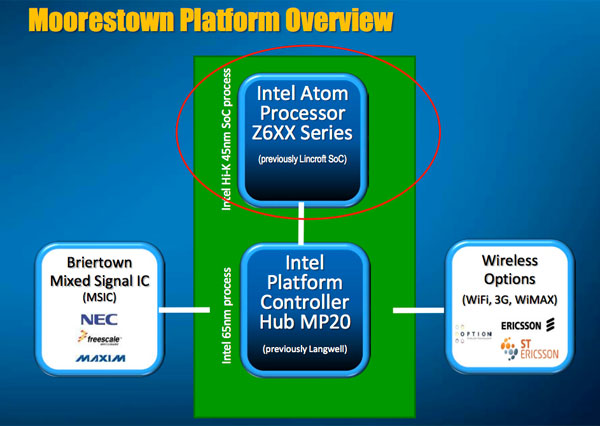
| Transistor Comparison | |||||
| Intel Atom Z5xx Series | Intel Atom Z6xx Series | NVIDIA Tegra 2 | |||
| Manufacturing Process | 45nm | 45nm | 40nm | ||
| Transistor Count | 47M | 140M | 260M* | ||
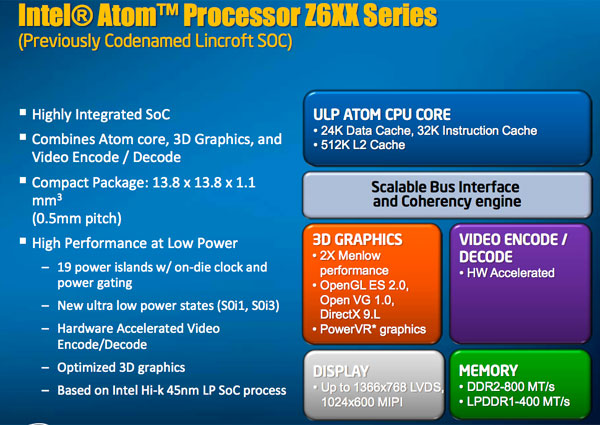
Langwell, now known as the Intel Platform Controller Hub (PCH) MP20, holds virtually everything else. It’s got an image processing core that supports two cameras (1 x 5MP and 1 x VGA), USB 2.0 controller, HDMI output (1080p) and a NAND controller that can support speeds of up to 80MB/s. The whole chip is managed by a 32-bit RISC core.
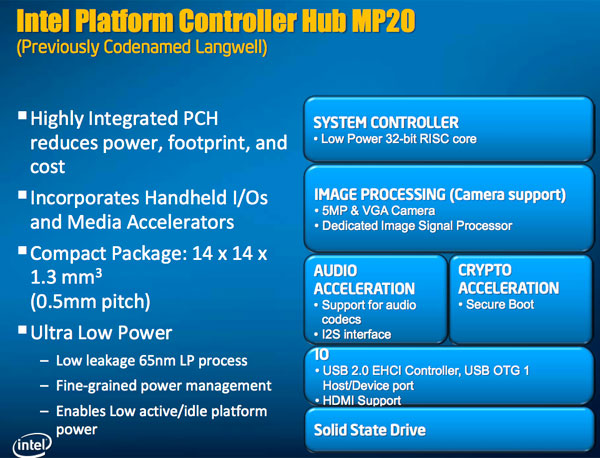
Langwell is a 65nm chip built at TSMC. TSMC has existing relationships with all of the IP providers for the blocks inside Langwell, so making it at TSMC is a sensible move (a temporary one though, with Medfield Intel will integrate all of this).
and_PlatformControllerHub_package2_sm.jpg)
Langwell (left) and Lincroft (right)
While Lincr, err, Atom Z600 and the Intel PCH MP20 are enough for a traditional system, they are not enough for a smartphone. You need wireless radios, that’s one chip for WiFi and one for 3G support. You need something to handle things like power management, charging the battery and controlling the touch screen. That’s an additional chip, called Briertown.
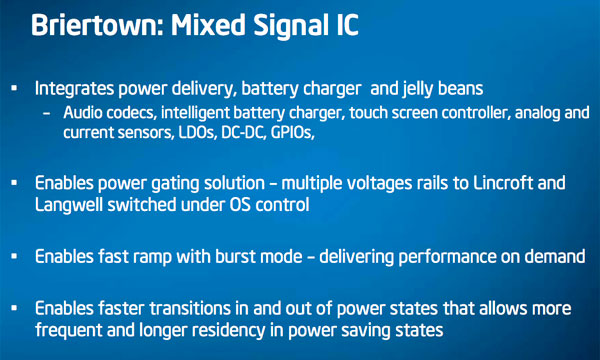
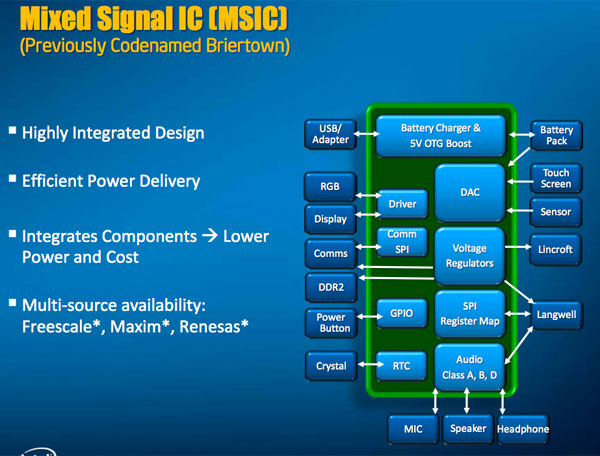
We’re up to four chips at this point, but you need at least one more. While modern day smartphone SoCs ship with on-package memory, Intel doesn’t yet support that. Obviously it’s not impossible to do, Marvell, TI, Qualcomm and Samsung do it with all of their SoCs. Look inside Apple’s iPad and you won’t see any DRAM chips, just a Samsung part number on the application processor package. Intel doesn’t have the same experience in building SoCs and definitely not in integrating memory so it’s not a surprise we don’t have that with Moorestown. Unfortunately this means a smartphone manufacturer will need as many as five discrete chips to support Moorestown.
| Platform Size | |||||
| Moorestown | |||||
| CPU + Chipset | 387 mm2 | ||||
| Total Platform Area | 4200 mm^2 | ||||
| SoC Package Size | 13.8 mm x 13.8 mm x 1.0 mm | ||||
| PCH Package Size | 14 mm x 14 mm x 1.33 mm | ||||
And now we know why Intel has been showing off its extremely long form factor prototype all this time:
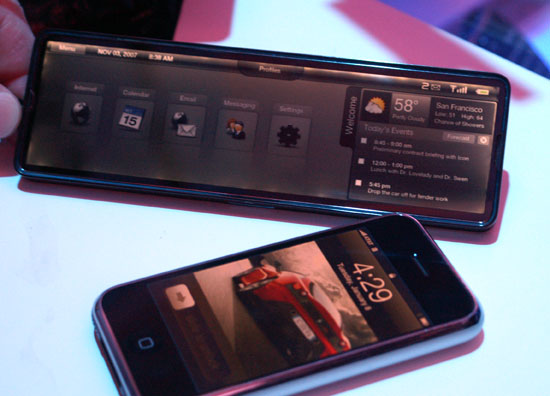










67 Comments
View All Comments
DanNeely - Wednesday, May 5, 2010 - link
I think you're misunderstanding the slide. It's not saying 1024x600 to 1366x768, it's saying upto 1366x768 on interface A, upto 1024x600 on interface B.Mike1111 - Wednesday, May 5, 2010 - link
Thanks for the clarification. Looks like I really misunderstood this sentence:"Lincroft only supports two display interfaces: 1024 x 600 over MIPI (lower power display interface) or 1366 x 768 over LVDS (for tablets/smartbooks/netbooks)."
uibo - Wednesday, May 5, 2010 - link
I wonder how many transistors are there in a Cortex A9 core? Just the core nothing else.For me it seems that ARM could just double or quadruple their core count against the Intel solution while still maintaining lower transistor count.
Also they could just increase the CPU clock speed, if there is a market for the more power-hungry Intel solution the there is one for the ARM also.
strikeback03 - Wednesday, May 5, 2010 - link
I would imagine even less smartphone software is written for multi-core now than was for desktop when dual-core CPUs started appearing in desktops. So going beyond 2 cores at this time is probably not a great move. Plus the dual core A9 isn't out to see power consumption yet, but even at 45nm I doubt it will be much below the current 65nm single-core chips if at all, so if Intel is already competitive then ARM doesn't exactly have the power budget to add cores.uibo - Thursday, May 6, 2010 - link
That actually makes sense. Nobody is going to write multi-threaded apps for a single thread CPU. I'd imagine that the number of apps, which experience is hindered by performance, is not that great at the moment. Games, browsers, UI, database for the info stored in your device - I'm not expecting these to scale perfectly across many cores but do expect a x0% performance increase.DanNeely - Thursday, May 6, 2010 - link
The real benefit for the 2nd core is probably multi-tasking. Your streaming music app can run in the background on the second core while your browser still has a full core to render web pages.Shadowmaster625 - Wednesday, May 5, 2010 - link
Mooresetown has to support a desktop OS. Intel is clearly moving towards wireless computing. They are bringing wireless video. With wireless video you can turn your phone into a desktop pc instantly by adding a wireless monitor and keyboard. What is the point of moving in that direction if you're moving towards a crippled OS? (Not that windows isnt crippled, if you consider obesity a form of cripple.)If it needs a pci bus, then emulate one!
Caddish - Wednesday, May 5, 2010 - link
Just registered to say keep up the good work. Since the SSD antology I have red all of your article like that one and they are awesomelegoman666 - Wednesday, May 5, 2010 - link
Excellent article, very well written.jasperjones - Wednesday, May 5, 2010 - link
Anand,You mention twice in the article that Apple and Google dominate the smartphone market. This is utter nonsense. The numbers from IDC as well as the numbers from Canalys clearly show that Nokia is the worldwide leader in the smartphone market. RIM is number 2. Apple is in the third place, the first company that produces Android devices, HTC, has the number 4 spot.
I realize that Nokia's market share in the U.S. is smaller than its global market share. However, even if we restrict ourselves to the U.S. market, RIM smartphone sales are bigger than those of Apple. They are also bigger than the sales of all Android smartphones combined.